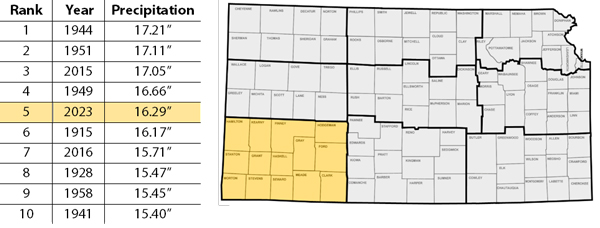The meteorological start of the 2023 growing season was on April 1. Since that date, above-normal precipitation has fallen in four of Kansas’ nine climate divisions: northwest, west central, southwest, and south central. Of these four, the division that normally averages the least precipitation, southwest Kansas has surprisingly been the wettest division in the state (Figure 1). When compared to previous years, southwest Kansas’ total precipitation from April 1 through July 31 this year has been unusually wet. The average precipitation across southwest Kansas for this 4-month period is 16.29 inches which rank as the 5th wettest April-July on record in that division, dating back to the start of official climate records in 1895 (Figure 1). This is the wettest April-July since 2015. Based on the period 1991-2020, the average precipitation for this period in southwest Kansas is 10.49 inches; this year precipitation is 5.80 inches above normal. By contrast, April-July 2022 was the 28th driest on record, when there was an average of just 7.71 inches of precipitation.
For the first 7 months of 2023, the average total precipitation in southwest Kansas is 17.25 inches, which ranks as the 9th wettest January-July on record. Thanks to the wetter-than-normal conditions this year, drought conditions across the southwest have greatly improved since this time last year (Figure 2).

Figure 1. The ten wettest April-July periods on record in southwest Kansas (shaded area), dating back to 1895. Source: National Centers for Environmental Information (https://www.ncei.noaa.gov).

Figure 2. US Drought Monitor status for southwest Kansas for July 26, 2022 (left) and July 25, 2023 (right). Source: National Drought Mitigation Center (https://droughtmonitor.unl.edu).
Of the 14 counties in southwest Kansas, Clark County has had the most precipitation this growing season (Table 1), with 19.23 inches. With respect to normal, Morton County is the most above normal, with a departure of +7.75 inches. The highest-ranked counties are Kearny and Stanton, where the growing season to date ranks as the 2nd wettest on record. The total rainfall amounts for Kearny, Morton, and Stanton County are the wettest since 1944, a period of 79 years, the longest in the division.
Table 1. Precipitation data for April 1-July 31, 2023 compared to historical records and 30-year normals (1991-2020). Source: National Centers for Environmental Information (https://www.ncei.noaa.gov). Shaded values represent the highest totals/ranks.
|
County |
Precipitation Apr. 1-Jul. 31, 2023 |
Apr. 1-Jul. 31, 2023 Rank Wettest |
Apr. 1-Jul. 31, 2023 Wettest Since |
Normal Apr. 1-Jul. 31 Precipitation |
Departure from Normal |
|
Clark |
19.23” |
4th |
2015 |
11.78” |
+7.45” |
|
Finney |
15.09” |
9th |
2015 |
10.69” |
+4.40” |
|
Ford |
15.69” |
10th |
2015 |
12.16” |
+3.53” |
|
Grant |
15.77” |
5th |
1949 |
9.33” |
+6.44” |
|
Gray |
16.01” |
8th |
2016 |
11.09” |
+4.92” |
|
Hamilton |
15.96” |
3rd |
1949 |
9.34” |
+6.62” |
|
Haskell |
16.24” |
10th |
2016 |
10.30” |
+5.94” |
|
Hodgeman |
13.52” |
32nd |
2020 |
12.15” |
+1.37” |
|
Kearny |
16.64” |
2nd |
1944 |
9.92” |
+6.72” |
|
Meade |
18.05” |
4th |
2015 |
11.17” |
+6.88” |
|
Morton |
16.41” |
3rd |
1944 |
8.66” |
+7.75” |
|
Seward |
17.18” |
4th |
2015 |
10.25” |
+6.93” |
|
Stanton |
15.75” |
2nd |
1944 |
8.87” |
+6.88” |
|
Stevens |
16.77” |
5th |
2015 |
9.31” |
+7.46” |
South Central Kansas Rainfall
The wettest counties in Kansas for the 2023 growing season to date are in south central Kansas. Comanche (19.76 inches, their 4th wettest on record), Harper (19.47 inches, 12th wettest), and Barber (19.44 inches, 6th wettest) are the top three. Southwest Kansas’ wettest county, Clark, ranks 4th in the state. Collectively, south central Kansas’ average precipitation since April 1st is 16.10 inches, less than two-tenths below southwest Kansas’ total. But since south central Kansas averages 4.40 inches more precipitation for this period (14.89 inches) than the southwest, their 2023 growing season total only ranks as the 31st wettest.
Looking ahead
So far, August is running a bit above normal; an estimated average of 1.09 inches has fallen across southwest Kansas since August 1st (as of August 8th; normal for the first 8 days of August is 0.83 inches). Normal precipitation for the entire month of August is 2.94 inches. The Climate Prediction Center’s outlook for August calls for above-normal precipitation statewide. For southwest Kansas to stay in the top 5 wettest growing seasons on record, at least 3.02 inches of rain must fall in August. Only 1.96 inches is needed to stay in the top 10. If August totals 3.92 inches or more, April-August 2023 would be the wettest on record in southwest Kansas for those five months. Will it happen? Stay tuned!
Matthew Sittel, Assistant State Climatologist
msittel@ksu.edu